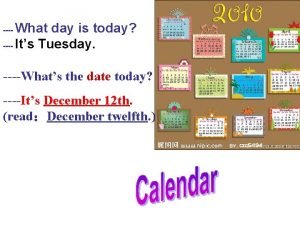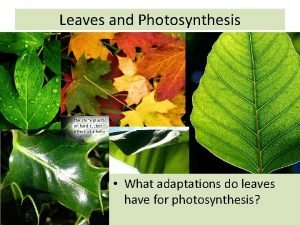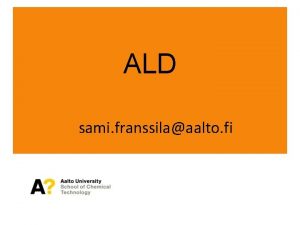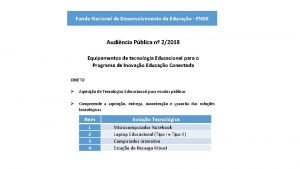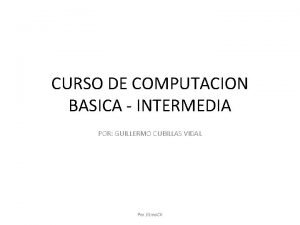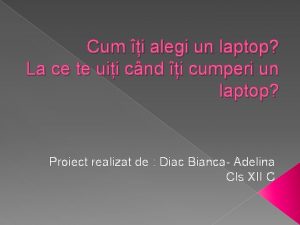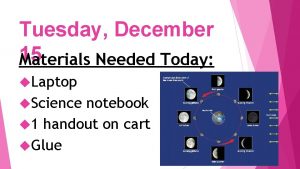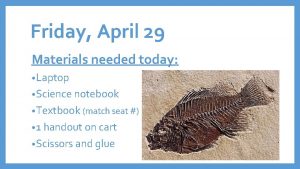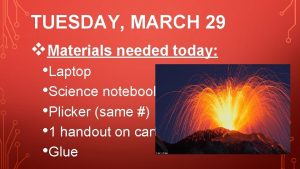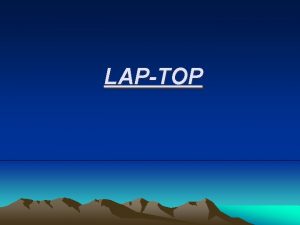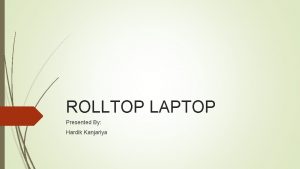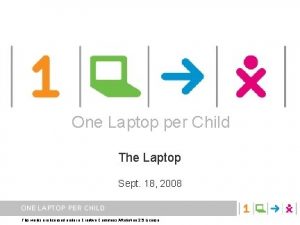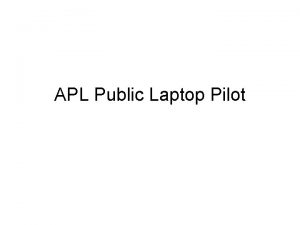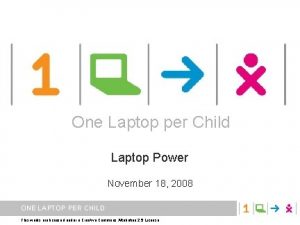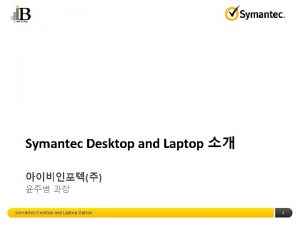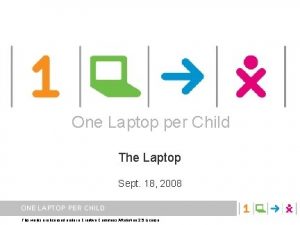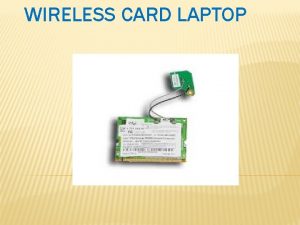Tuesday April 19 Materials needed today Laptop Science















- Slides: 15

Tuesday, April 19 Materials needed today: • Laptop • Science notebook • Textbook (match seat #) • 2 handouts on cart • Scissors & glue

COMPOSITION OF THE EARTH

MINERALS OF EARTH’S CRUST Chapter 5 Sections 1 -2

Objectives Section 1: What is a Mineral? 1. Define mineral. 2. Compare the two main groups of minerals. Section 2: Identifying Minerals 3. Describe seven physical properties that help distinguish one mineral from another. Self-Evaluation Rubric 1. I can’t do any of this by myself. 2. I can do a little bit with a lot of help. 3. I can do most of this without any help. 4. I can do all of this without any help.

Characteristics of Minerals • Mineral - a natural, inorganic solid that has: characteristic chemical composition 2. an orderly internal structure 3. a characteristic set of physical properties 1.

Characteristics of Minerals • To be a mineral, a substance must have four main characteristics: 1. It must be inorganic – it cannot be made of or by living things. 2. It must occur naturally – it cannot be man-made. 3. It must be a crystalline solid – it has a predictable structure. 4. It must have a consistent chemical composition – it is the same throughout.

Check • What four characteristics of a substance makes it a mineral? It must be inorganic. 2. It must occur naturally. 3. It must be a crystalline solid. 4. It must have a consistent chemical composition. 1.

Kinds of Minerals • Rock-forming minerals – the 20 most common minerals that form the rocks that make up Earth’s crust. • Ten minerals are so common that they make up 90% of Earth’s crust. • All minerals can be classified into two main groups - silicate minerals and nonsilicate minerals - based on their chemical compositions.

Kinds of Minerals Silicate Minerals • Silicate mineral - a mineral that contains a combination of silicon and oxygen. • May also contain one or more metals. • Common silicate minerals include quartz, feldspars, and ferromagnesian minerals, such as amphiboles, pyroxenes, and olivines. • Silicate minerals make up 96% of Earth’s crust. • Quartz and feldspars alone make up more than 50% of the crust.

Kinds of Minerals Nonsilicate Minerals • Nonsilicate mineral - a mineral that does not contain compounds of silicon and oxygen. • Nonsilicate minerals are organized into six major groups based on their chemical compositions: carbonates, halides, native elements, oxides, sulfates, and sulfides. • Nonsilicate minerals make up about 4% of Earth’s crust.

Check • What is the difference between silicate and nonsilicate minerals? • Silicate minerals contain • Nonsilicate minerals do not silicon and oxygen. contain silicon and oxygen.

Physical Properties of Minerals • Mineralogist - a person who examines, analyzes, and classifies minerals. • Each mineral has specific properties that result from its chemical composition and crystalline structure. • These properties provide useful clues for identifying minerals. • Many of these properties can be identified by simply looking at a sample of the mineral or through simple tests.

Physical Properties of Minerals Foldable • Follow the instructions to create the foldable.

Physical Properties of Minerals Color • A mineral’s color is easy to observe, but color alone is not a reliable clue for identifying a mineral sample because it can change. • The color of a mineral sample can be affected by the inclusion of impurities or by weathering processes.

Physical Properties of Minerals Foldable • Use pages 117 -120 to fill in the foldable. 1. Describe each property. 2. Summarize the main ideas that go with each property. 3. Add the following words to your index: • color, streak, luster, hardness, cleavage, fracture, density, crystal shape
 Is today tuesday
Is today tuesday Materials and tools in making simple electrical gadgets
Materials and tools in making simple electrical gadgets Set up trays and trolleys materials
Set up trays and trolleys materials Importance of ecology
Importance of ecology Today meeting or today's meeting
Today meeting or today's meeting In today's class
In today's class Today meeting or today's meeting
Today meeting or today's meeting Fingerprint galton details
Fingerprint galton details Today's lesson or today lesson
Today's lesson or today lesson Today's lesson or today lesson
Today's lesson or today lesson What's your subject
What's your subject Materials today
Materials today Laptop educacional - tipo i - educação conectada
Laptop educacional - tipo i - educação conectada Computacion intermedia
Computacion intermedia Cum alegi un laptop
Cum alegi un laptop Clemson laptop requirements
Clemson laptop requirements
